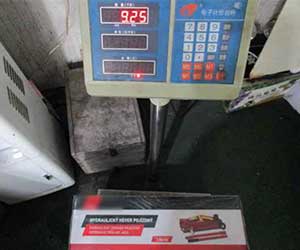Hydraulic trolley jack
Specification:
-Lift range:135-325MM
-Size:439x190x135MM
-Load capacity:1 ton
-Style: floor jack
Feature:
-The ideal tool for all your lifting needs
-Reliable and sturdy, made from high-quality steel for maximum safety and durability
-Easy to use and durable
-Heavy-duty metal construction
-Lifts to 2 tons
-With ergonomically designed handles and a lightweight design
What is the car hydraulic jack?
Hydraulic jacks can lift heavy loads over greater distances and commonly use in the automotive, industrial, and construction industries. Hydraulic jacks help lift heavy loads.
There are two types of hydraulic jacks, the bottle jack and the floor jack. As the name implies, the bottle jack is portable and has a vertical piston with a weight-bearing pad. Bottle jacks are commonly used with vehicles and help change wheels. The jack is positioned under the car at the correct point for raising the vehicle, then using a detachable lever, the jack pumps up, so increasing the vehicle allows the wheel to be changed. A floor jack has horizontal pistons and a long arm providing vertical lifting motion. Floor jacks have wheels or castors and are often in garages. These jacks can lift a heavier load than bottle jacks.
Hydraulic jacks work by compressing hydraulic fluid into the jack cylinder by using a pump plunger. Pushing the plunger forward draws hydraulic fluid into the pump chamber, and pulling the plunger back into the cylinder draws hydraulic fluid out. Hydraulic fluid is removed from the pool into the pump chamber so that when the plunger moves forward, the hydraulic fluid pushes back into the cylinder. This fluid movement increases pressure in the cylinder, making the hydraulic jack work.
Heavy loads can lift higher and more robust hydraulic jacks. Tiroflx’s Hydraulic Trolly Jack reassembles a Trolley in Shaped, having a cylindrical body and a neck from which the vertical and directly supports a bearings pad that contacts the lifted object.
A car jack is vital whenever you need to raise your car to carry out a repair or maintenance that requires you to get underneath the vehicle. But many types of jack are available, so which should you choose?
There are main types of car jack: the trolley jack, bottle jack and scissor jack and trolley jack.
Floor Jacks:
Floor jacks are essential tools that assist you in elevating the car you’re working on. Thanks to hydraulics, you can promote a piece of the vehicle using a hand lever. These gadgets are powerful and can use a little mechanical knowledge to use.
Consider the vehicle’s weight when selecting floor jacks for your car. Floor jacks should generally be for at least three-fourths of your vehicle’s weight. Even though a floor jack only raises a section of your automobile, not the total weight, overloaded jacks may be dangerous. They’re also more challenging to use.
Most floor jacks include wheels, making them simple to manoeuvre throughout your garage. However, their weight and bulk make them less portable for on-the-go use.
Bottle Jacks:
A bottle jack is a hydraulic jack with an expanded cylindrical body that resembles a bottle. Bottle jacks function similarly to a regular hydraulic floor jack, except they can carry greater weight. They also raise the car off the ground. One of the drawbacks of this function is that it requires a greater starting clearance, making it more challenging to operate on lower cars.
Bottle jacks are less expensive than floor jacks, making them useful as a backup set for mechanics and as the primary equipment for hobbyists and home repair enthusiasts.
Scissor Jacks:
Scissor jacks employ a hand crank to elevate a car when correctly positioned. Scissor jacks are appropriate for lighter vehicles since their capacity is generally at one or two tonnes. Depending on your model, they also feature a modest lift height, ranging from 15 to 30 inches.
A scissor jack’s main advantage is its safety, especially compared to high-lift and agricultural jacks, which need more care and skill. In comparison to floor jacks, scissor jacks are also lightweight and cost-effective. It makes them a great choice if you need a portable jack to move about quickly.
Trolley Jack:
The trolley jack, which can lift up to 4 tonnes and move through mud and gravel, has a brake mechanism. It is one of the safest and easiest jacks to operate in many situations; it is another good option for automotive maintenance.
Automotive repairs, specific high-clearance equipment maintenance, and medium to heavy construction projects are possible applications.
Is a 2-ton jack enough for a car?
A two-ton jack can raise a corner on most sedans and small cars. You may need twice that rating (four tons) for pickup trucks and SUVs to ensure safety.
What kind of car jack do you need?
Your budget, your car’s weight, and the clearance of the vehicle will all influence the kind of jack you require. When selecting a car jack, portability is another factor to consider. For the majority, all they need in an emergency is a scissor jack. Due to their height and recovery ability, high-lift and exhaust air jacks are preferable for off-roading. Floor or bottle jacks are excellent choices if you need something for your garage.
Various types of jacks are for lifting cars at different capacities.
















